OUTLINE LESSONS 10 and 10b
Pure Monopoly
10a - Monopoly: Charcteristics and Short-Run
Equilibrium
|
I. Introduction:
A. Four Product Market Models
1. Competitive
Market (Lessons 8/9a, 8/9b)
2. Monopoly
(Lessons 10a, 10b)
3. Monopolistic
Competition (Lesson 11a)
4. Oligopoly
(Lesson 11b)
B. General Outline for Each Model
1. Characteristics and Examples
2. Nature of the Demand Curve
3. Short Run Equilibrium (Profit Max.)
4. Long Run Equilibrium and Efficiency
5. Other Issues
II. MONOPOLY - Characteristics
A market structure in which
one firm sells a unique product into which entry is blocked in
which the single firm has considerable control over product price
and in which nonprice competition may or may not be found.
A. NUMBER OF FIRMS: single firm
B. TYPE OF PRODUCT: unique product, no close substitutes
C. CONTROL OVER PRICE: "price makers"
D. EASE OF ENTRY: blocked entry
E. NONPRICE COMPETITION: public relations
III. Examples / Importance
|
1.
|
Public utilities: gas, electric, water, cable TV, and
local telephone service companies, are often pure
monopolies.
|
|
2.
|
Central Microprocessors (Intel), First Data Resources
(Western Union), Wham-o (Frisbees), Brannock Device
Company (shoe sizing devices), and the DeBeers diamond
syndicate are examples of "near" monopolies. (See Last
Word.)
|
|
3.
|
Manufacturing monopolies are virtually nonexistent in
nationwide U.S. manufacturing industries.
|
|
4.
|
Professional sports leagues grant team monopolies to
cities.
|
|
5.
|
Monopolies may be geographic. A small town may have
only one airline, bank, etc.
|
Why Study Monoplies?
- because they really do exist
- and because most industries are a combination of pure
competition and pure monoply
- monopolistic competion
- oligopoly
IV. Barriers to Entry
A. Definition
Anything which
artificially prevents the entry of firms into an
industry.
B. Importance of Barriers
C. Types of Barriers
1. economies of scale: costs
a) graphically
b) rationale
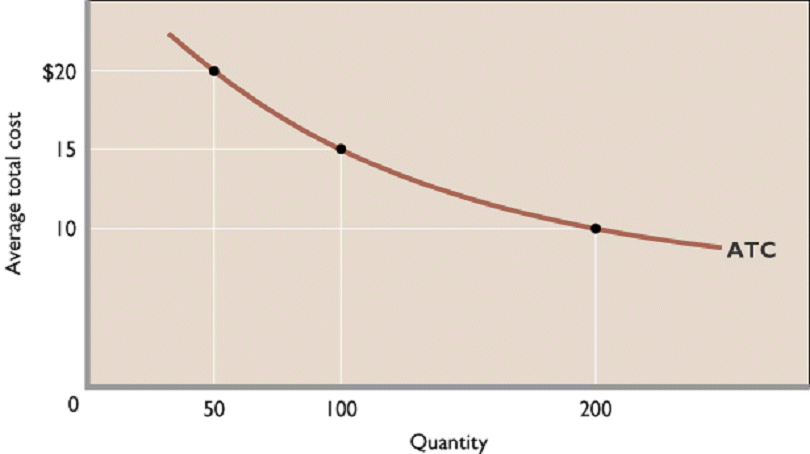
c) natural monopolies
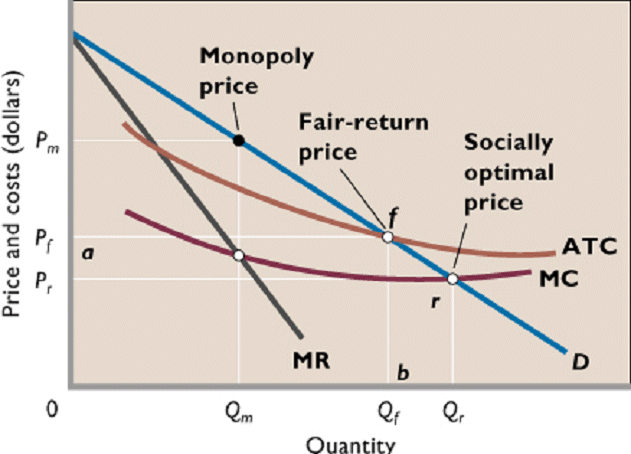
3. legal barriers
a) patents
b) licenses
3. ownership or control of essential raw
materials
4. pricing and other strategic barriers
V. Price and Output Determination: Benefit-Cost
Analysis
A. Monopoly Demand
1. Assumptions
- barriers to entry secure the firm's monoploy
- no government regulation
- a single-price monopoly - that is, it charges the
same price to all of its customers (no price
discrimination)
2. firm's demand = market demand (demand is
downsloping)
- P > MR
- price maker
- the monoplolist sets the price in the elastic region
of demand
- in the inelastic region a lower price (to sell
more) would lower total revenue even though it costs more
to produce more
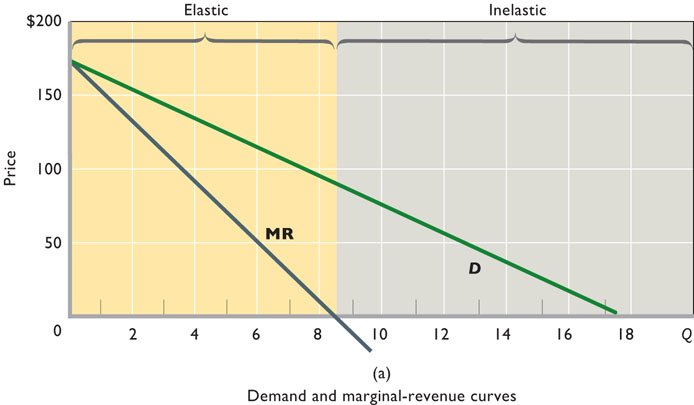
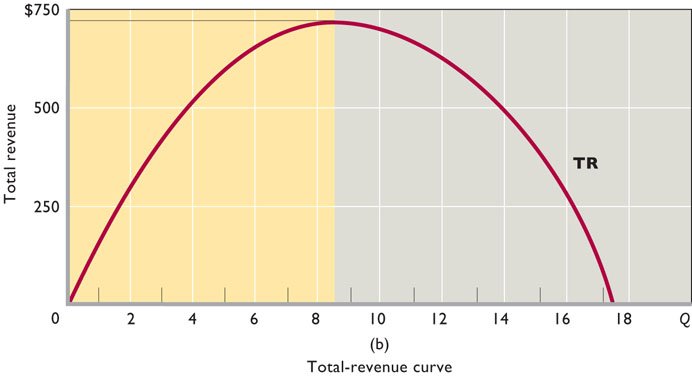
B. Price and Output Determination
1. goal: profit maximization
2. benefit-cost analysis 2 steps (graphically)
a) find best quantity where MR = MC
b) product only if AR > AVC
C. Profits? (graphically)
1. profit
maximizing case: economic profits ( profits/losses)
2. loss
minimizing case( profits/losses)
extra
3. shut
down case ( profits/losses)
extra
4. normal
profit ( profits/losses)
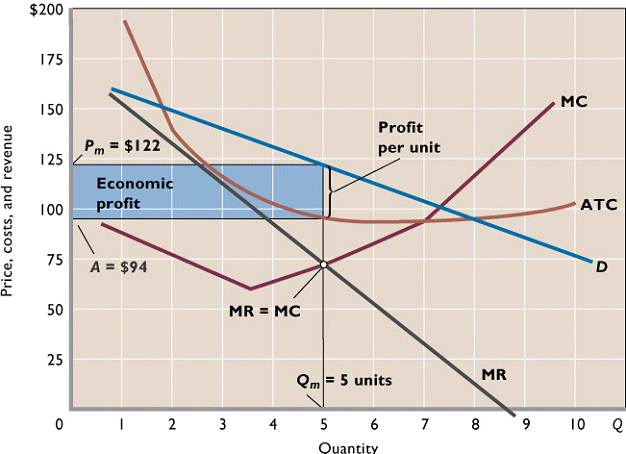
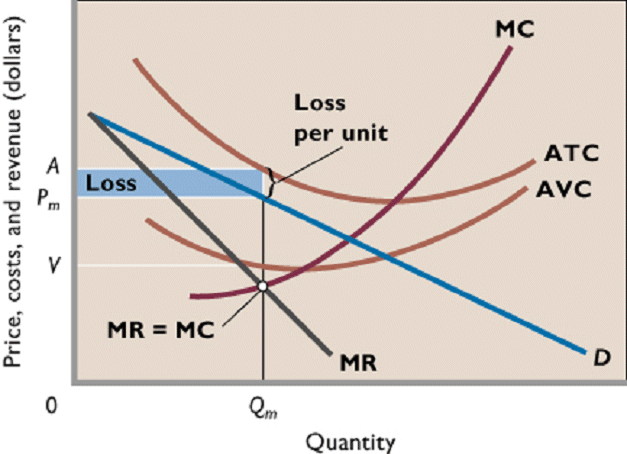
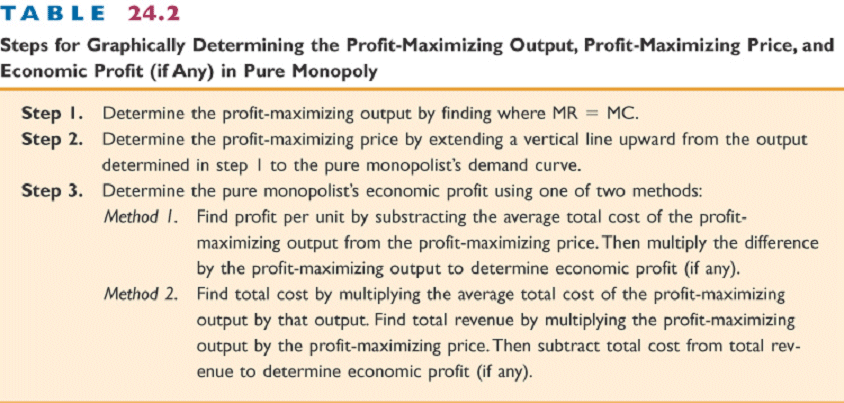
D. Misconceptions Concerning Monopoly Pricing
1. not highest price
2. total, not unit, profits
3. losses
4. graph
VI. Price and Output Determination TC - TR Approach
10b - Monopoly: Long-Run, Efficiency,
and Regulation
|
VII. Monopoly Firms and Long Run Equilibrium
Monopoly:
Long-Run Equilibrium Graph
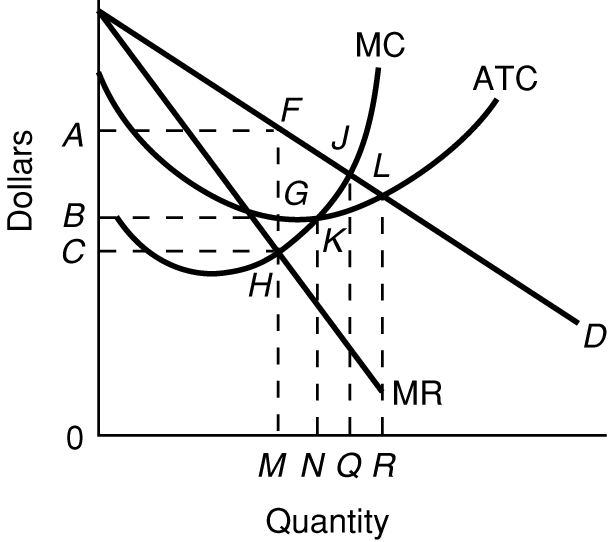
VIII. Monopoly Firms and Efficiency
A. Competitive Firms and Efficiency (review)
1. allocative efficiency: P = MC
2. productive efficiency: P = MC = ATC
B. Assume Identical Costs
C. Monopoly [GRAPH]
1. allocative inefficiency: P >MC
a) underallocation of resources smaller output
than competitive markets
b) higher prices than competitive markets
2. productive inefficiency
a) not producing at minimum ATC
b) cost complications
1) natural monopoly
An
industry in which economies of scale are so great the
product can be produced by one firm at a lower average
total cost than if the product were produced by more
than one firm.
graphically
2) X-inefficiency
Failure to
produce any specific output at the lowest average (and
total) cost possible.
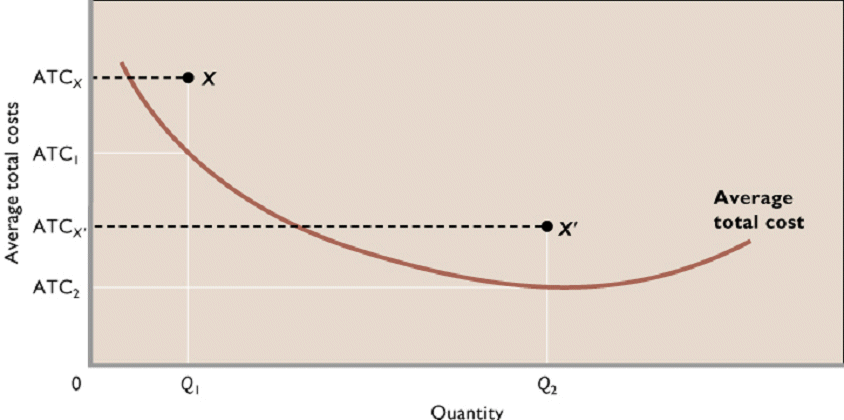
3) monopoly
preserving expenditures
4) dynamic efficiency?
(a) competitive model
(b) monopoly model
(1) means
(2) incentives?
(3) a mixed picture
- Some monopolies have shown little interest
in technological progress
- On the other hand, research can lead to
lower unit costs, which help monopolies as much
as any other type of firm. Also, research can
help the monopoly maintain its barriers to entry
against new firms.
- MORE
(c) the inverted-U theory of R &D
expenditures
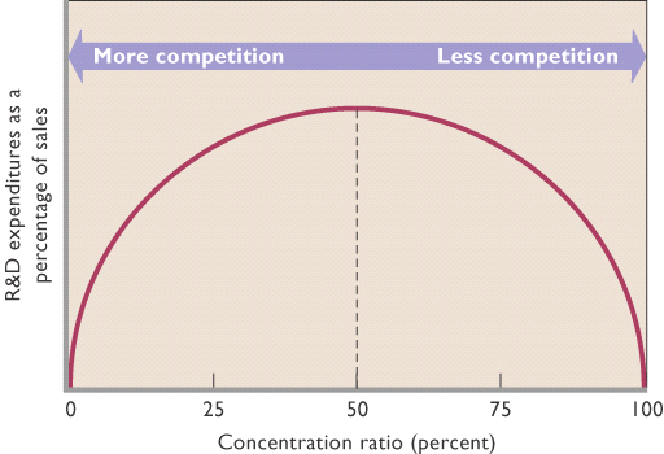
3. inequities (income distribution)
- Income distribution is more unequal than it would be
under a more competitive situation.
- The effect of the monopoly power is to transfer income
from consumers to business owners.
- This will result in a redistribution of income in favor
of higher-income business owners, unless the buyers of
monopoly products are wealthier than the monopoly
owners.
IX. Price Discrimination
A. Definition
The selling of a product
to different buyers at different prices when the price
differences are not justified by differences in cost.
B. Examples: Who pays more? / Who pays less?
1. ELECTRICITY: heating or lighting? homes or
businesses?
2. DOCTORS: insured patients or uninsured?
3. AIR TRAVEL: business travellers or
vacationers?
4. MOVIES / SKIING / GOLF: adults or children?
5. RAILROADS: expensive cargo or inexpensive
cargo?
6. COUPONS
7. INTERNATIONAL TRADE
8. OTHERS ????
C. Conditions
1. Monopoly power ( price maker )
2. Market segregation: ability to segregate buyers
according to their price elasticity of demand
3. No resale
D. Consequences (graphically)
1. more profits
2. more production = more efficient
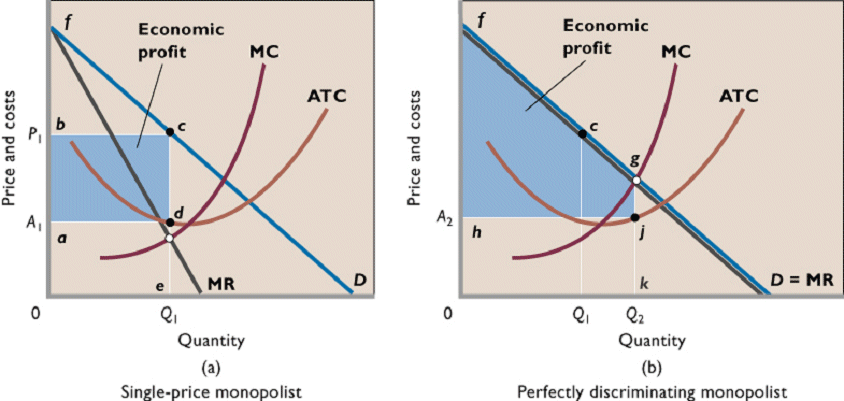
X. Regulated Monopoly: Rate Regulation
A. Why rate regulation instead of antitrust?
1. definition: antitrust
The use of the
antitrust laws to promote competition and economic
efficiency.
2. natural monopoly
An
industry in which economies of scale are so great the
product can be produced by one firm at a lower average total
cost than if the product were produced by more than one
firm.
3. graphically:
demand crosses ATC while ATC is still downward
sloping
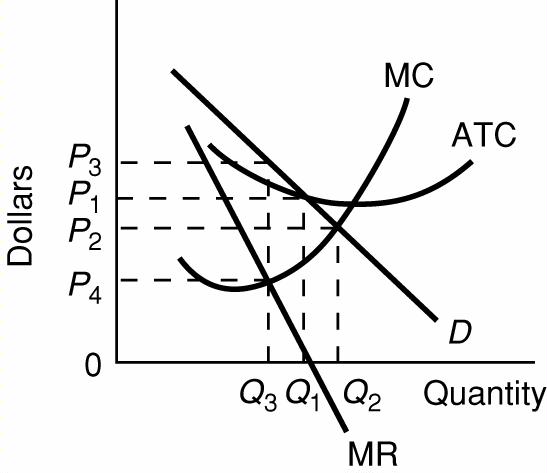
B. Why government gets involved
1. to improve allocative efficiency: "public
interest "
The presumption that
the purpose of the regulation of an industry is to protect
the public (consumers) from abuse of the power possessed by
natural monopolies.
2. political reasons: legal cartel theory
The hypothesis that
some industries seek regulation or want to maintain
regulation so they may form or maintain a legal
cartel.
a. Proponents of this theory
contend that regulators guarantee a return to the regulated
firms while blocking entry and dividing up the market -
activities that would be illegal in unregulated
markets.
b. Occupational licensing is
an example of this theory in certain labor
markets.
C. How the government regulates rates (prices)
1. P = MC: socially optimum price (alloc. eff.
price)
a. Definition
The price of a product which
results in the most efficient allocation of an economy's
resources and is equal to the marginal cost of the
product.
Means the same thing as
ALLOCATIVE EFFICIENCY
b. graphically
c. achieves allocative efficiency
The price of a
product which results in the most efficient allocation of
an economy’s resources and is equal to the marginal
cost of the product.
c) but results in a loss for the firm
d) government could subsidize or use AC
pricing
2. P = ATC: "fair" return price
a. definition
The price of a
product which enables its producer to obtain a normal
profit and which is equal to the average total cost of
producing it.
b. graphically
c. some inefficiency
d. but normal profits earned no losses
3. Review: GRAPH

|

Unregulated Profit Maximizing Price and Quantity:
P3 and Q3
(where MR = MC)
Allocatively Efficient Price and Quantity: P2 and
Q2
(where P = MC)
Fair Return Price and Quantity: P1 and Q1
(where P = ATC)
|
D. Dilemma with Industrial
Regulation
The tradeoff a regulatory
agency faces in setting the maximum legal price a monopolist
may charge:
The socially optimal price is
below average total cost (and either bankrupts the firm or
requires that it be subsidized) while the higher fair-return
price does not produce allocative efficiency.
E. Deregulation in the United States
1. Deregulation came about in the 1970s and 1980s
as a result of the greater acceptance of the legal cartel
theory, increasing evidence of inefficiency in regulated
industries, and the contention that government was regulating
potentially competitive industries.
2. Industries that were deregulated included airlines,
trucking, banking, railroads, natural gas, television
broadcasting, electricity, and telecommunications.
3. Although some criticize deregulation, on balance it
appears to have benefited consumers and the economy.
a. Benefits to society through lower prices,
lower costs, and increased output are estimated at $50
billion annually. The gains come primarily from airlines,
railroads, and trucking.
b. Deregulation has lead to technological advances in
new and improved products.
4. Deregulation in the electricity industry has generated
significant controversy.
a. The industry is most deregulated at the
wholesale level. This allows wholesalers to build facilities
and sell electricity to distributors at unregulated
prices.
b. Some states have also deregulated retail
electricity prices and, for the most part, electricity rates
have fallen for consumers.
c. In California, where wholesalers are deregulated
and retailers regulated, a dramatic increase in wholesale
prices in 2001 resulted in substantial financial losses for
retail providers, as they were legally prevented from
raising retail prices to cover the higher costs. The problem
was exacerbated by the fraudulent activities of
energy-trader Enron.
XI. De Beers' Diamonds: Are Monopolies Forever?
A. De Beers Consolidated Mines of South Africa has
been one of the world's strongest and most enduring monopolies.
1. It produces about 50 percent of all rough-cut
diamonds in the world
2. and buys for resale many of the diamonds produced
elsewhere,
3. for a total of about 80 percent of the world's
diamonds.
B. Its behavior and results fit the monopoly model portrayed
in the figure below It sells a limited quantity of diamonds that
will yield an "appropriate" monopoly price.

C. The "appropriate" price is well over production costs and
has earned substantial economic profits.
D. How has De Beers controlled the production of mines it
doesn't own?
1. It convinces producers that "single-channel"
monopoly marketing is in their best interests.
2. Mines that don't use De Beers may find the market flooded
from De Beers stockpiles of the particular kind of diamond they
produce, which causes price declines and loss of profits.
3. Finally, De Beers purchases and stockpiles diamonds
produced by independents.
E. Threats and problems face De Beers' monopoly
power.
1. New diamond discoveries have resulted in more
diamonds outside their control.
2. Russia, which has been a part of De Beers' monopoly, has
been allowed to sell a part of its stock directly into the
world market.
F. In mid-2000, De Beers abandoned its attempt to control
the supply of diamonds.
G. The company is transforming itself into one that sells
"premium" diamonds and luxury goods under the De Beers
label











